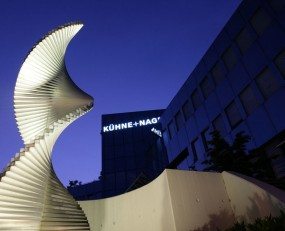
Kuehne and Nagel has suffered a mild hit from the tightening of shipping markets. For the first half of 2017 its key sea freight-forwarding division saw revenue up by 8.4% but gross profit fell by 2.7% and EBIT (Earnings Before Interest and Tax) fell by 10.4%. Measured in TEU (Twenty Foot Equivalent Units), volumes increased by 7.7% in a market that K+N says is growing 4%. It appears that what the forwarder describes as a “fierce competitive environment” depressed its margins and the company sacrificed profit for volume. The situation improved somewhat in the second quarter of the year and it will be interesting to see how K+N responds to the higher freight rates being experienced now.
Air freight saw an even greater leap in volumes, up 18% year-on-year as measured in tonnage. But again margins were not as strong, leading to a 13.7% increase in turnover, 3.3% in gross profit and 2.7% in EBIT. Even this profit growth K+N ascribed to “strict cost control and productivity increases due to process automation”. Presumably the air freight carriers must be putting considerable pressure on K+N.
‘Overland’ trucking business did much better. Turnover was up 3.3% and EBIT almost doubled year-on-year, from CHF17m in H1 2016 to CHF29m in H1 2017.
Contract Logistics also did reasonably well, with turnover up 3.9% and EBIT 5.7% higher. This appears to represent a trend of sustained recovery in this sometimes troubled business, with investment in new assets hiding a greater increase in profitability.
Overall the half year numbers were reasonable. For the whole group net turnover was up 8.2% to CHF 8,815m whilst EBITDA (Earnings Before Interest, Depreciation and Amortisation) was up 1.3% at CHF554m. What will be key however is the response to the changing market conditions in both sea containers and air freight in the second half of the year. Volumes will undoubtedly go up but K+N may have to choose between higher volumes or higher profits.
Source: Transport Intelligence, July 20, 2017
Author: Thomas Cullen